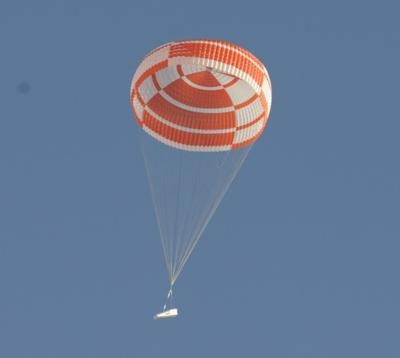Designed To Return From Low Earth Orbit Autonomously
Europe’s IXV Intermediate eXperimental Vehicle is completing a series of descent and landing tests, including a full-scale splashdown planned for early next year, allowing the mission to move ahead towards launch in 2014. The ambition for a spacecraft to return autonomously from low orbit is a cornerstone for a wide range of space applications, including space transportation, exploration and robotic servicing of space infrastructure. More maneuverable and able to make precise landings, XIV is the ‘intermediate’ element of Europe’s path to future developments with limited risks.

Launched into a suborbital trajectory on ESA’s small Vega rocket from Europe’s Spaceport in French Guiana, the vehicle will return to Earth as though from a low-orbit mission. For the first time, it will test and qualify European critical reentry technologies in hypersonic flight, a requirement for all future applications that include a return from orbit. The descent and landing are key because they will allow the recovery of the vehicle and its precious recorded data for inspection, and serve as a backup in the event of a telemetry failure with ground stations.
Multiple failures during these phases in past national and international test flights have prompted ESA to ensure the recovery of the vehicle and data by using a robust design and rigorous verification. Specific tests at system and subsystems level have been added to the standard qualification approach, including splashdown attitude verification tests in Rome, Italy, at the INSEAN research institute, a parachute subsystem qualification test at the US Yuma Proving Ground, and a descent and landing system test in Sardinia, Italy, at Poligono Interforze Salto di Quirra (PISQ).
Attitude verification tests during splashdown were concluded in September 2011 with a prototype. They verified several vehicle splashdown scenarios at different angles, ranging from –35° to +71°, and wind conditions, in longitudinal and lateral directions. This has revealed the ideal water impact angle to minimise loads and preserve the vehicle’s structure to be +35°.
The parachute qualification test was completed in June 2012, verifying the behaviour of the complex subsystem, including its multiple stages. A second prototype integrating the subsystem was dropped from a plane at an altitude of 5.7 km (18,700 feet) and landed safely in the Arizona desert. Flight testing of the descent and landing system is planned for the first quarter of 2013. It aims to verify the behaviour of the complete descent and landing system chain, ensuring the recovery of the vehicle.
A third full-scale prototype is undergoing integration at Italy’s CIRA research center, including flight hardware and software. It will be dropped from a helicopter at an altitude of 3 km (about 10,000 feet), splashing down in the Mediterranean Sea in the PISQ test range off the coast of Sardinia. In parallel, industry is moving ahead with building and qualifying all flight elements, including the vehicle and the ground support equipment, and ground elements such as the mission control center and tracking stations. “In addition to the retrieval of flight data in real time via telemetry, securing the descent and landing phases of the IXV mission for the recovery of the vehicle intact is the requirement of utmost importance for the project,” says Giorgio Tumino, IXV Project Manager.
“Following past national and international experimentation failures, a lot of pressure is on industry to strengthen the failure tolerance in the design and verification approach of such critical flight phases."
“The IXV mission into space is now becoming a concrete reality. It will provide Europe with credible and unique know-how on atmospheric reentry system aspects and unknowns and flight-proven technologies essential to support the realisation of the Agency’s future ambitions in the field.”
(Image provided by ESA)
 ANN's Daily Aero-Linx (04.15.24)
ANN's Daily Aero-Linx (04.15.24) Classic Aero-TV: 'No Other Options' -- The Israeli Air Force's Danny Shapira
Classic Aero-TV: 'No Other Options' -- The Israeli Air Force's Danny Shapira Aero-News: Quote of the Day (04.15.24)
Aero-News: Quote of the Day (04.15.24) Airborne 04.16.24: RV Update, Affordable Flying Expo, Diamond Lil
Airborne 04.16.24: RV Update, Affordable Flying Expo, Diamond Lil ANN's Daily Aero-Term (04.16.24): Chart Supplement US
ANN's Daily Aero-Term (04.16.24): Chart Supplement US



